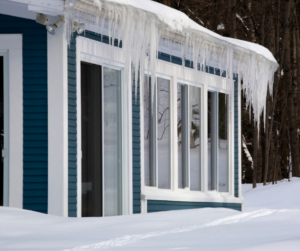What to Know About Ice Dams on Your Roof
 Roofs are durable, which is good because they take a lot of wear and tear from the elements, especially water and ice. Water can cause many problems to various types of roofs including asphalt, wood, metal, etc., but some of the biggest problems arise when the water can’t properly drain, such as in the case of ice dams.
Roofs are durable, which is good because they take a lot of wear and tear from the elements, especially water and ice. Water can cause many problems to various types of roofs including asphalt, wood, metal, etc., but some of the biggest problems arise when the water can’t properly drain, such as in the case of ice dams.
If you want to know more about ice dams and what to do about them, check out these frequently asked questions.
What Is an Ice Dam?
When rain hits your roof, it usually slides into the gutters and away from your home. When snow accumulates on your roof, however, it can impede water flow. This is because snow melts unevenly. Due to the heat from your home, the insulation inside the house, and the sun, the snow in the middle of the roof melts first, leaving the edges still frozen.
As the water continues to melt, it heads for the gutters, but the ice dam may prevent the water from finding an exit. This leads to standing water on your roof, which increases the chance of rot or decay from the water; this water can penetrate the shingles to create a leak inside the home.
Ice dams can also build if you fail to keep your gutters cleaned. Gutters filled with debris become clogged, which impedes drainage. If this water freezes, snow accumulates on the gutters to create an ice dam directly on the gutters. If your gutters are involved, the weight of the ice and snow can cause damage or even rip them from the home.
Can You Prevent Ice Dams?
To prevent ice dams, start by maintaining your gutters so they don’t become clogged or can’t properly drain. This will help water flow naturally, so it doesn’t pool on the roof. You may also want to consider installing a gutter-protection system, which will help keep debris from entering the gutters.
Another way to help stop ice dams from forming is by preventing heat loss though the roof. Heat escaping your home via the roof is what causes the snow to melt unevenly. One way to stop heat from escaping is to seal any holes around ducts, pipes, etc. that pass into the attic and/or through the roof.
If the problem persists, however, you likely need to improve your attic’s ventilation. This process may simply mean ensuring the vents inside the attic are clean and free from blockage, but you may need to install new vents to ensure the hot air in the attic has some place to escape other than through the roof.
Can You Safely Remove Ice Dams?
You can remove ice dams, however, you should not try to chisel or hammer the ice, as this could damage the gutters or roof, which will only cause more drainage issues, water buildup, and leaks.
One easy way to fix a newly formed ice dam is with a roof rake. While on the ground, use the roof rake to slowly pull the snow off the roof. Make sure you are mindful where you are standing, and where the snow is falling. If thick ice or icicles are already forming, contact a professional to avoid damage and injury.
You may also need to create a path for melted water to reach the gutters or ground — use calcium chloride ice melt in a pantyhose. The chemical slowly and safely melts the ice, giving the trapped water a place to escape.
Homeowners should care for their roof, so it can stay looking and working great. Proper maintenance is the most important key. If you would like more information about maintaining or repairing your roof, contact us at Ray’s Hartford Home Improvement Contractors Inc. today.

